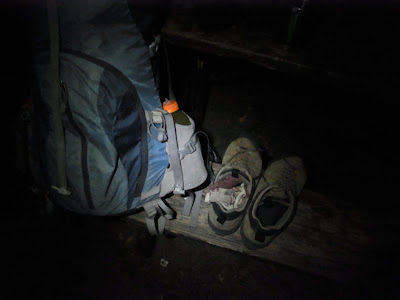 |
| The Washington Column |
So, this is my first attempt at a blog post, in order to share with everyone not on facebook. Fitting that it was also my first attempt at a Wall, much less first attempt at doing a Wall Solo.
I've been in the Valley for some time now, and have been slowly losing my ambition for lots of hard climbing. It's difficult to stay motivated, and honestly much easier to go hangout by the river than it is to wake up early, slog all morning on an approach, then spend all day climbing.
After escaping the last rain storm, and recovering/recuperating in Reno/the Bay Area, a new plan was hatched. Upon my return to the Valley, I would have a goal to works towards: I was going to climb a big wall, and I was going to do it by myself.
 |
| There's plenty of rock here |
Climbing big walls is a lot of work. Like, A LOT of work. You have to carry enormous packs up to the base of the wall, climb the wall itself (usually so difficult you have to resort to a type of climbing known as Aid climbing), haul your packs up the wall, then find a way off.
Normal climbing might involve carrying a 3-5 pound pack with some energy bars, a water bottle, rain jacket, and hiking shoes. Wall climbing often involves packs in the 75-100 pound range. The weight increases exponentially when you have to spend the night on the wall. You need more water, more gear, and all kinds of other junk, all of which at some point you have to drag up the wall.
A friend once described it like this: "Imagine spending all day digging ditches, anytime you get to rest, you're resting hanging in your harness hundreds of feet off the ground. You eat terrible canned food, ration your water supplies, and sleep in the most uncomfortable positions imaginable. Chances are, whatever item you need most, you probably forgot on the ground/dropped at some point. It's miserable."
 |
| Heavy packs. And this is without the ropes. |
At least ditch-diggers get paid, we do this for fun.
To add to this misery, I would be attempting to climb solo. Generally, you undertake an endeavor like this with a partner. Somewhere to share the work with, someone to complain to, someone to blame when shit hits the fan. Without one, you're on your own. You do all the work, take all the blame, but walk away with all the glory if it goes right.
Generally, people move to soloing big walls after a lot of experience doing them with partners. Having a partner is more forgiving, the two of you can work any complications out that arise more easily. Rope stuck? Your partner can get it while you do other things. Haul bag too heavy? The two of you can haul it together. Can't figure out a climbing sequence? Discuss it together.
Screw up when you're alone, well, you're screwed.
With all this in mind, I spent a few days practicing solo aid climbing. I've never aid climbed before, so this was quite the learning experience. In aid climbing, you place gear into a crack in the rock, attach ladders to it, and climb up these.
 |
| Looking down on the many placements of an aid climb. |
If free climbing is ballet, aid climbing is engineering. You're using the gear you have to solve the problem of moving up the rock. In my opinion, it's dragging the rock down to your ability. Essentially you are admitting you cannot climb this and must resort to means of artificial aid to get up, but hey, it allows you to get up things normally unobtainable to you.
So, with a couple short climbs under my belt, I decided to embark on a big climb: The South Face of the Washington Column. Realistically, the amount of experience I had was laughable, and could easily have practiced x10 more before attempting something like this, but hey, I'm in for an adventure, not a walk in the park. This climb would be technically easier, but logistically difficult for someone used to free climbing like me. It would require at least one night on the wall, and the added difficulties of bringing enough food, water, and other supplies to not die.
 | |
| Oh how I love those 5am starts. |
With nothing left to do but get at, I got at it. Having scoped out the approach the night before and dropped off half the gear, I headed up in the early morning to the base of the climb.
 |
| The approach is steep, woo hoo. |
 |
| The first pitch. |
 |
| Jugging the ropes (ascending back up the rope I just put up). |
Normally, in a team of two, each person climbs each pitch (typically 100-200ft) only once. The first person puts the gear in and moves the rope up, and the second takes the gear out and brings the rope. By myself, I would essentially repeat each pitch three times: 1. put gear and rope in while moving up 2. rappel down and remove gear 3. ascend back up the rope then pull the rope up.
It's tiring, but the views can be great.
But soon, I reached my accommodations for the night. A ledge so plush and luxurious, it's name is the Awanhee Ledge (the awanhee being the nicest hotel in the valley).
 | |
| My ledge! |
 |
| I'll take one master suite please, with room service. |
To be continued......

